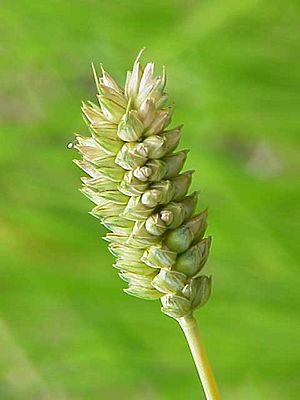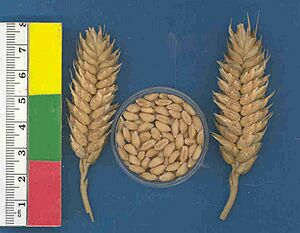Triticum compactum facts for kids
Quick facts for kids Triticum compactum |
|
|---|---|
 |
|
| Scientific classification | |
| Genus: |
Triticum
|
| Species: |
compactum
|
| Subspecies | |
|
T. compactum humboldtii |
|
Club wheat (scientific name: Triticum compactum) is a type of wheat that grows well in places with low humidity. It's very similar to common wheat (T. aestivum). In fact, many people think it's just a special kind of common wheat.
You can tell club wheat apart because its "ear" (where the grains grow) is more compact. This is why it's called "club" wheat! In the United States, most club wheat is grown in the dry areas of the Pacific Northwest.
Club wheat is a hexaploid plant. This means it has 21 chromosomes, which is more than many other plants. Farmers have carefully bred club wheat to have less protein. This makes flour from club wheat perfect for baking delicious cookies! Like other types of bread wheat, club wheat has never been found growing wild.
Contents
History of Club Wheat
Club Wheat in the Middle East and Europe
The first forms of club wheat likely appeared in ancient Syria. This was during the Neolithic period, a time when people first started farming. From Syria, club wheat spread across Europe. For a long time, people thought it was the oldest type of wheat grown in Europe.
Club wheat first arrived in Europe during the Neolithic Era, reaching places like Spain by 4600 BC. There is also proof that the Romans grew club wheat in Portugal and France around 100-200 BC. Even in Finland, club wheat was grown between the 5th and 7th centuries AD.
Club Wheat in North America
People once thought club wheat came to North America from Chile in the 1960s and 70s. However, scientists found old club wheat in adobe bricks (a type of mud brick) from missions in California. This showed that club wheat was in California by 1787. It was probably brought by Spanish explorers through Mexico.
Club wheat was very important in California's early farming history. It was even grown more than common wheat back then! One special kind, called T. compactum erinaceum (or California Club Wheat), had red chaff (the protective covering of the grain). This type sadly disappeared before 1822.
As American wheat farming grew in the early 1900s, common wheat became more popular. Today, club wheat is often grown alongside common wheat because they are so similar.
What Club Wheat Looks Like (Morphology)
Club wheat is a small type of wheat that easily separates from its outer covering when harvested. Its grains are round. Like other bread and club wheats, it has a keel (a ridge) on the top part of its glume (the outer part of the flower).
Club wheat also has a smaller, slightly bent crease on its grains. The "cheek" area at the brush end (the tip of the grain) is also smaller.
How to Identify Club Wheat
You can mostly tell club wheat apart from common wheat by its shorter stem segments and its compact ear. This compact ear is how it got its name! The now-extinct California club wheat (T. compactum erinaceum) could be identified by its red chaff and more hairy stem.
Ancient Club Wheat
Most old club wheat was grown between the Neolithic era and the Bronze Age. Because of this, the most common way we find ancient club wheat is as carbonized (burnt) remains. Even when burnt, wheat can often look like its fresh form. Scientists can usually identify it using the same methods as fresh wheat.
However, sometimes the burnt wheat is damaged or incomplete. If a type of wheat with round grains and a broken stem is found in Europe (except Italy or the Balkan peninsulas), it's usually a hexaploid club wheat (either T. aestivum or T. compactum). If this wheat has short stem segments, it's identified as T. compactum.
Life Cycle of Club Wheat (Agronomy)
In the northern part of the world, club wheat usually flowers in June and July. Its seeds are ready to be harvested in August and September. Club wheat is an annual plant. This means it grows for one season, reaching about 0.6 meters (about 2 feet) tall in the summer, and then dies in the winter.
See also
 In Spanish: Trigo racimoso para niños
In Spanish: Trigo racimoso para niños


